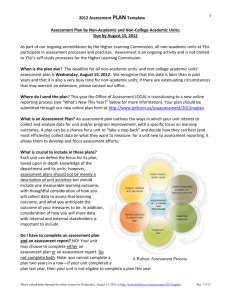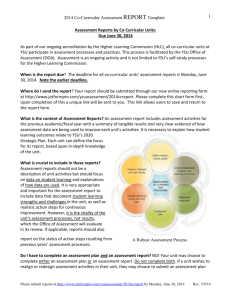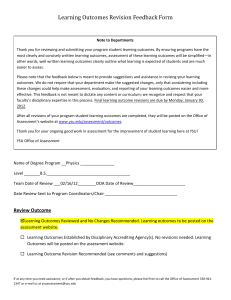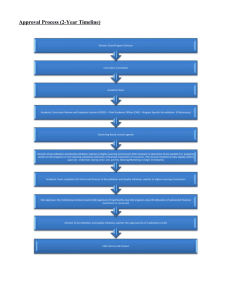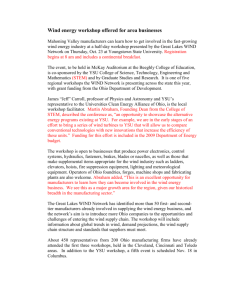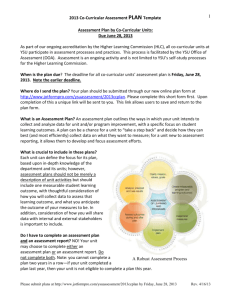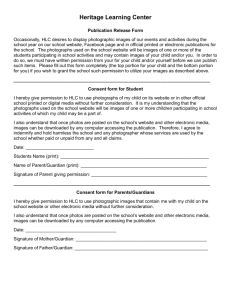Assessment Reports by Non-Academic and Non
advertisement
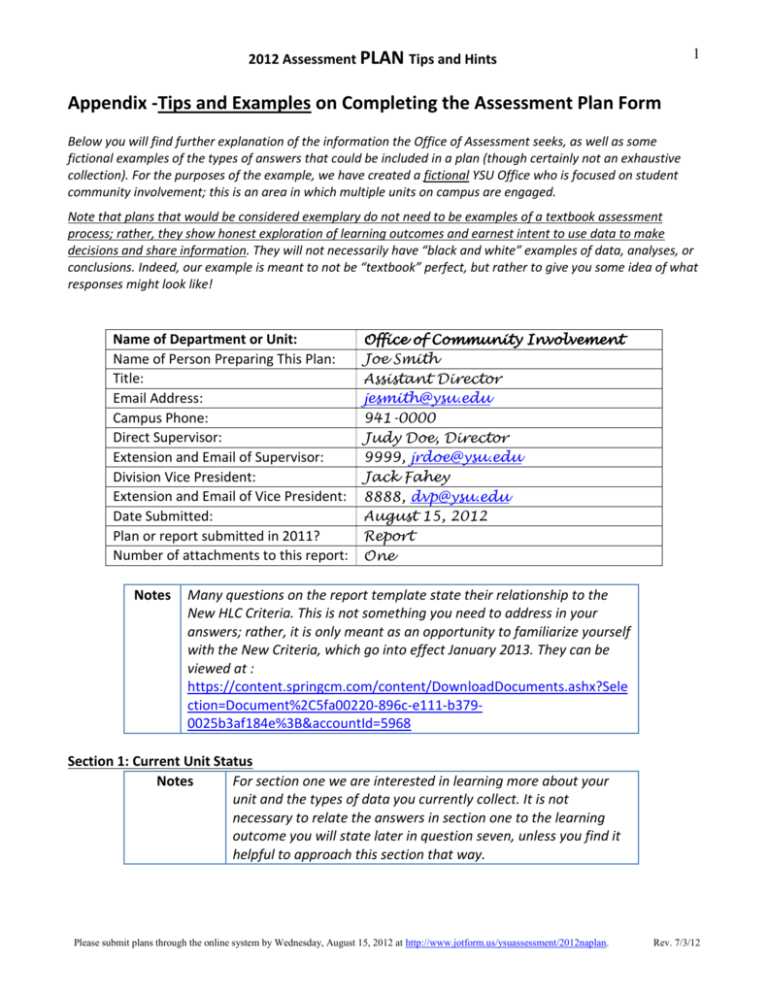
1 2012 Assessment PLAN Tips and Hints Appendix -Tips and Examples on Completing the Assessment Plan Form Below you will find further explanation of the information the Office of Assessment seeks, as well as some fictional examples of the types of answers that could be included in a plan (though certainly not an exhaustive collection). For the purposes of the example, we have created a fictional YSU Office who is focused on student community involvement; this is an area in which multiple units on campus are engaged. Note that plans that would be considered exemplary do not need to be examples of a textbook assessment process; rather, they show honest exploration of learning outcomes and earnest intent to use data to make decisions and share information. They will not necessarily have “black and white” examples of data, analyses, or conclusions. Indeed, our example is meant to not be “textbook” perfect, but rather to give you some idea of what responses might look like! Name of Department or Unit: Name of Person Preparing This Plan: Title: Email Address: Campus Phone: Direct Supervisor: Extension and Email of Supervisor: Division Vice President: Extension and Email of Vice President: Date Submitted: Plan or report submitted in 2011? Number of attachments to this report: Notes Office of Community Involvement Joe Smith Assistant Director jesmith@ysu.edu 941-0000 Judy Doe, Director 9999, jrdoe@ysu.edu Jack Fahey 8888, dvp@ysu.edu August 15, 2012 Report One Many questions on the report template state their relationship to the New HLC Criteria. This is not something you need to address in your answers; rather, it is only meant as an opportunity to familiarize yourself with the New Criteria, which go into effect January 2013. They can be viewed at : https://content.springcm.com/content/DownloadDocuments.ashx?Sele ction=Document%2C5fa00220-896c-e111-b3790025b3af184e%3B&accountId=5968 Section 1: Current Unit Status Notes For section one we are interested in learning more about your unit and the types of data you currently collect. It is not necessary to relate the answers in section one to the learning outcome you will state later in question seven, unless you find it helpful to approach this section that way. Please submit plans through the online system by Wednesday, August 15, 2012 at http://www.jotform.us/ysuassessment/2012naplan. Rev. 7/3/12 2 2012 Assessment PLAN Tips and Hints 1. Explain how your unit supports the 2020 Strategic Plan of Youngstown State University (The YSU 2020 Strategic Plan can be found at http://web.ysu.edu/2020.) (Related to HLC Criterion 1, Core Component 1.A, Sub-component 2 and HLC Criterion 3, Core Component 4.E., Subcomponent 1) Notes Relate your unit’s purpose to at least one cornerstone/theme/priority of the 2011-2020 Strategic Plan. You do not have to provide an exhaustive list of how your unit relates, only an example or two. The 2020 Strategic Plan, Theme 2.2 is Satisfaction with Example non-academic experiences and campus life—the explanation under this theme specifically includes the importance of participation in service learning and community activities. Our unit’s main goal is to increase participation in community activities as well as meaningful reflection on the impact of those activities on students’ development. 2. Describe the goals for your unit from the previous academic/fiscal year. Notes What are your unit’s goals, either focused on the past year, or if you do not do yearly goals, what are the overall goals of your unit? Our unit had three main goals this past year: 1. Example Increase Office of Community Involvement’s visibility on the YSU campus; 2. Increase student participation in community volunteer activities through our office; and 3. Increase partnerships with Youngstown area schools for students to serve as tutors. 3. How do your goals support the learning environment at YSU? (Related to HLC Criterion 4) Notes Every unit on campus contributes to the learning environment, because the learning environment impacts not just students, but faculty and staff. Units that do not include significant student contact also contribute to the learning environment. Note that you can choose to focus broadly on what your office does, or specifically on the area you are considering for the plan. Participation in community service activities helps Example students learn about civic responsibility and better understand the community and region in which we live. In addition, participation in these activities helps to produce graduates that are prepared to be involved citizens, able to utilize the knowledge gained through their degree program to better our region and the world. Please submit plans through the online system by Wednesday, August 15, 2012 at http://www.jotform.us/ysuassessment/2012naplan. Rev. 7/3/12 3 2012 Assessment PLAN Tips and Hints Describe your current assessment activities: 4. Provide a brief summary of unit and/or program improvement data collected that document your unit’s assessment activities for the 2011-12 academic/fiscal year (e.g., explain how you measured unit and/or program activities for continuous improvement). (Related to HLC Criterion 4, Core Component 4.B., Sub-component 2) Notes 1. This does not need to be data related to your learning outcome, only focused on continuous improvement. 2. You can provide just a list of the types of data, you don’t need to include the actual data (e.g. “the numbers”). 3. We would like to know what data you have been collecting because: 1)this will help us provide feedback on collecting data for your learning outcome and 2) data collection should be an ongoing process, even in planning years We fielded a survey in fall 2011 asking students about Example their participation in community service activities and their knowledge of opportunities for community service participation on the YSU campus. We track student participation in programs through our office; we have been collecting this data yearly for the past five years. 5. How was that data analyzed and used by your unit? (Related to HLC Criterion 4, Core Component 4.B., Sub-component 3) Notes This does not have to be a formalized process, e.g., it could be a discussion of the data that came out of a unit meeting. We want to know how you have used data in the past to help evaluate and make decisions. The survey of student participation helped us Example understand that first year students, in particular, were not aware of community engagement opportunities on campus. We are currently in the planning stages of how to target first-year students more directly about opportunities. In addition, the survey revealed that students don’t understand the impact of community involvement on their academic and personal development. We are also in the planning stages of incorporating a more compelling case for students to participate—e.g. “what’s in it for them” if they participate in our programs. Building this case is particularly important since many of our students work at jobs off campus as they complete their academic coursework. Please submit plans through the online system by Wednesday, August 15, 2012 at http://www.jotform.us/ysuassessment/2012naplan. Rev. 7/3/12 4 2012 Assessment PLAN Tips and Hints 6. How did your unit utilize feedback from the Office of Assessment regarding last year’s assessment report? (Note: if this is your unit’s first time completing a plan or report, answer “first reporting year.”) Notes Refer to your feedback from the 2011 plan or report to aid in completing this question; if you met personally with Office of Assessment staff, feedback from that meeting would also be appropriate to include. The feedback said we should communicate with Example stakeholders more widely, specifically those outside our unit. This is one of the reasons we decided to complete an assessment plan this year, to allow us time to identify those groups and develop a plan to communicate with them in the future. Section 2: Assessment Plan Development Develop a learning outcome: Notes The intent of questions 7-9 is to facilitate alignment of assessment activities in the continuum from the specific activity (learning outcome, and resulting data collection), to the unit, through to the larger university. For more on learning outcomes, you can contact the Office of Assessment. 7. State at least one learning outcome1 (LO) that is relevant for your unit. Note: you may use the same LO used in a past year or you may use/develop a new LO. (Related to HLC Criterion 4, Core Component 4.B., Sub-component 1) Notes A learning outcome should be clearly written, measurable, and focused on a single skill or knowledge set. For questions 7-9 only, we show an example of both a student-focused and staff-focused learning outcome. Students will be more aware of the importance of Example community involvement to their education. (student focused LO) Staff demonstrate awareness of professional Example (staff focused responsibilities of students serving in community organizations. LO) 8. How does this learning outcome fit your unit? Notes Specifically relate the learning outcome you have chosen to the purpose of your unit. 1 For information on what a learning outcome is and how to construct one for your unit, please attend the Office of Assessment workshop on assessment plans in July 2012 or see the website at www.ysu.edu/assessment/directions.html for workshop materials. Please submit plans through the online system by Wednesday, August 15, 2012 at http://www.jotform.us/ysuassessment/2012naplan. Rev. 7/3/12 5 2012 Assessment PLAN Tips and Hints Example (student focused LO) Example (staff focused LO) This is directly related to our unit’s purpose, to promote the benefit of community involvement to our students. By ensuring our staff are responsive to the needs of the community organizations with which we partner, and therefore maintain a positive working relationship, we are well positioned to continue and expand our students’ community service opportunities. 9. How does this learning outcome fit in with the YSU 2020 Strategic Plan? (Related to HLC Criterion 1, Core Component 1.A, Sub-component 2 and Criterion 3, Core Component 4.E., Subcomponent 1) Notes Specifically relate the learning outcome you have chosen to the 2020 strategic plan. Promoting the importance of community involvement Example helps to encourage participation, and the Regional (student focused LO) Engagement Cornerstone outlines the importance of Example (staff focused LO) student involvement in the community to support quality learning experiences and positive community change (in particular Theme 1, Priority 1). By maintaining positive and responsive relationships with our community partners, we enable students to interact positively with community partners, and foster the collaborative relationships with community organizations outlined in the Regional Engagement Cornerstone (in particular Theme 1, Priority 1). Relate your learning outcome to Higher Learning Commission (HLC) Criteria: 10. (OPTIONAL FOR 2012) Please provide an example of evidence from your unit for the new HLC Criterion Five (Resources, Planning, and Institutional Effectiveness), Core Component 5A (The institution engages in systematic and integrated planning.), Sub-component 2 (The institution links its processes for assessment of student learning, evaluation of operations, planning, and budgeting.): Notes This question is optional, but a good way to begin familiarizing yourself with the New HLC Criteria that goes into effect on January 1, 2013. Consider how the assessment activities you are planning may impact your planning and budget decisions. Remember also: this question is asking how the work of your unit contributes to YSU meeting this HLC criteria; it is the work of many academic and non-academic units that helps YSU to meet the requirements (i.e., your unit is not solely responsible). Please submit plans through the online system by Wednesday, August 15, 2012 at http://www.jotform.us/ysuassessment/2012naplan. Rev. 7/3/12 6 2012 Assessment PLAN Tips and Hints Example While we didn’t think of it this way before reading this question, the 2011 survey results made it clear that more staff and financial resources needed to be devoted to a campus campaign. Through this assessment plan, we are devoting both fiscal and staff resources in order to carry out plans. Results from this year’s assessment will inform future planning and budgets. Measure your learning outcome: 11. What is the way (or ways) you will measure the status of and/or progress in this learning outcome over the 2012-13 academic/fiscal year? Note: consider tools that would incorporate both direct and indirect measures Notes While you must have a minimum of one tool/measure, we recommend no more than two. You can use perceptions or attitudes to look at the impact of your unit’s activities on faculty, staff, or student learning. Measuring perceptions is an indirect measure. It is also possible to measure individuals’ factual knowledge about information they learned during a staff development workshop or as a result of completing community service or participating in a learning community. This would be considered a direct measure. Note that an exemplary rating on this item would be for a unit that includes a direct measure in its tools. In spring 2013 e will repeat the survey (see attachment) Example given in fall 2011 asking students about their awareness and participation in community service activities as an indirect measure after our fall 2012 awareness campaign. The fall 2011 can serve as “baseline data”, and we can look for any changes after the awareness campaign. 2 12. What do you anticipate the outcome of your measure(s) to be? What do you hope to find out? Notes This is your sense of what you hope to find. Remember that your estimate of what you expect to find may not be realized and it does not just have be focused on positive results e.g. your results may turn out differently than you expected. That is fine. Remember that unexpected findings can lead to another valuable question that you can address at a future time. Even if you anticipate that the findings may be “negative” (i.e. individuals lack knowledge), that is not a bad thing because it is that honest appraisal or finding that can lead to continuous Note: there are no actual “fictional” attachments; this is meant only to point out that additional evidence can be attached to a report when needed. 2 Please submit plans through the online system by Wednesday, August 15, 2012 at http://www.jotform.us/ysuassessment/2012naplan. Rev. 7/3/12 7 2012 Assessment PLAN Tips and Hints improvement Example We hope to see some increase in the awareness of students regarding the availability and importance of community service activities, but we aren’t sure how much impact it will have on actual involvement (since this is a closely related goal). Close the feedback loop: As part of a healthy assessment process, assessment activities and highlights should be shared with, and feedback and recommendations solicited from, both internal stakeholders (such as unit staff) as well as external stakeholders (such as students, other staff/faculty, and the wider community). 13. What are the major constituency groups for your unit? Note: think not just within your unit or your supervisory structure (internal stakeholders), but about students/faculty/staff, the larger university, the surrounding community, and beyond (external stakeholders). Notes Who is impacted by (either directly or indirectly) or interested in your work? A lot of people are interested in what you are doing and can benefit from hearing about your project. Internally, we should share the information with all Example our staff as well as the Division VP. Externally, we think students would be interested in our work and there are several other units on campus who do work in community involvement (such as University Honors and Scholars, WYSU, and Alumni Services) that we could share our information with. 14. How and when do you plan to involve your major constituency groups in the assessment process (e.g., data sharing and recommendation gathering)? (Related to HLC Criterion 4, Core Component 4.B., Sub-component 3) Notes Explain when and with what groups you will share the findings of what you intend to examine. It is important to include groups outside your own unit. Make an effort to not just share findings passively (e.g., put on a website) but also actively (e.g., presentations, discussions); it is also an opportunity to ask the key groups what they see in the data and might recommend to improve the unit. We will compile the results from our survey and share Example the information with the groups listed above through: monthly meetings with internal staff to update, present data, and solicit recommendations; soliciting a story about the results in the Jambar for students (spring 2013); and inviting other campus units to come in person for a presentation and discussion of the data (April 2013). Please submit plans through the online system by Wednesday, August 15, 2012 at http://www.jotform.us/ysuassessment/2012naplan. Rev. 7/3/12 8 2012 Assessment PLAN Tips and Hints Executive Summary: 15. Executive Summary (summarize the key ideas from section two only, Assessment Plan Development, with a maximum length of one-half page). Optional: 16. Is there anything else you would like to share regarding your assessment plan and/or is there any particular area on which you would like assistance or feedback? Notes The Office of Assessment and the Assessment Council want to hear about your questions and let us know what information or assistance you may need We reference some work in the plan that is not directly Example related to the learning outcome,—we didn’t feel like we wanted to limit response to those questions to just learning outcome related answers. Also, we are not certain how to incorporate a direct measure with this learning outcome—do you have any ideas? Please submit plans through the online system by Wednesday, August 15, 2012 at http://www.jotform.us/ysuassessment/2012naplan. Rev. 7/3/12
